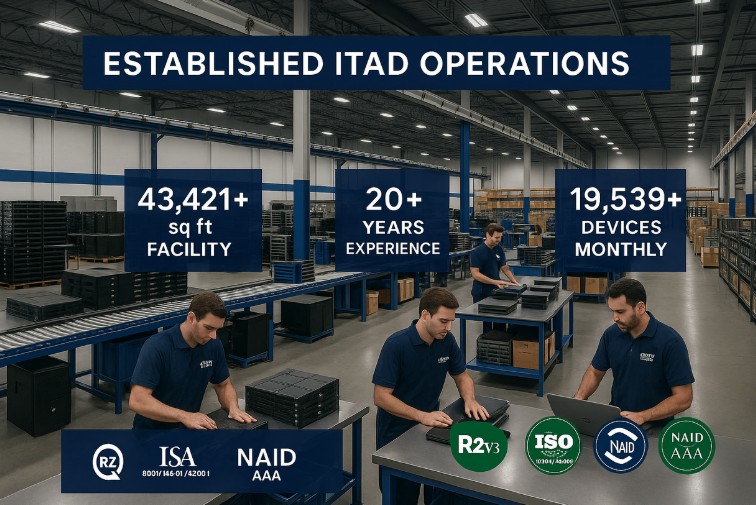Imagine discovering that 40% of drives your organization thought were sanitized still contain sensitive data or realizing your company contributed to the 62 million tons of e-waste generated in 2022, of which only 22.3% was properly recycled. These alarming statistics reveal critical gaps in how organizations manage IT asset disposition. Without a comprehensive ITAD policy, enterprises risk data breaches, regulatory violations, and environmental liabilities, each capable of millions in losses. The difference between a secure, compliant operation and a high-risk one often comes down to having a well-defined ITAD policy that governs the entire IT asset lifecycle.
Understanding IT Asset Disposition (ITAD)
Definition and Importance
IT asset disposition (ITAD) refers to the systematic process of retiring, repurposing, or disposing of IT information in a manner that protects data, meets regulatory standards, and supports environmental sustainability. This critical business function goes beyond simple disposal it requires strategic planning to ensure sensitive data is fully erased and any remaining asset value is recovered.
Modern enterprises generate substantial volumes of e-waste due to frequent technology refresh cycles, organizational changes, and equipment failures. With the average cost of a data breach reaching $4.88 million in 2024, secure IT asset disposition has become an essential element of enterprise risk management and compliance strategies.
Role in Asset Management
ITAD represents the final phase in an organization’s broader IT asset management (ITAM) strategy, ensuring that end-of-life equipment is properly processed. When supported by robust asset management tools, organizations can track each IT asset from procurement through final disposition, maintaining visibility over location, condition, and security status.
Key asset management benefits include:
- Enhanced data security through verified data destruction and chain-of-custody tracking
- Regulatory compliance with industry frameworks and legal mandates
- Cost recovery through refurbishment, resale, or component harvesting
- Environmental sustainability via certified recycling and e-waste reduction
Key Components of Effective ITAD
Data Sanitization and Destruction
Data sanitization represents the most critical component of any ITAD policy, requiring the complete removal of all information from storage devices before equipment leaves an organization’s control. Research shows that ~40% of drives believed to be sanitized still contain recoverable data, highlighting the importance of implementing proven sanitization techniques.
Primary sanitization methods include:
- Logical erasure using software tools compliant with NIST Special Publication 800-88
- Cryptographic erasure that renders encrypted data unreadable by destroying encryption keys
- Physical destruction that mechanically damages storage media to prevent data recovery
Organizations must implement sanitization methods based on data classification levels, regulatory requirements, and equipment value. NAID AAA Certification provides a widely recognized benchmark for secure data destruction, ensuring the complete elimination of sensitive information from electronic media.
Asset Tracking and Management
Comprehensive asset tracking enables organizations to maintain complete visibility into IT equipment throughout its lifecycle. Modern asset tracking databases integrate with ERP systems to provide real-time information about equipment location, condition, and disposition status.
Essential tracking elements include:
- Unique asset identification through barcode or RFID tagging systems
- Location monitoring to track equipment movement and storage
- Condition assessment to document equipment status and functionality
- Chain of custody that maintains security throughout the disposition process
Effective asset tracking improves theft recovery rates by up to 85%, according to insurance industry data.
Value Recovery Strategies
Strategic value recovery maximizes financial returns from retired IT assets while supporting environmental sustainability objectives.
Common value recovery opportunities include:
- Refurbished equipment sales, extending asset lifespan through professional restoration
- Component harvesting, recovering valuable parts for spare inventory
- Material recovery, extracting precious metals and other valuable materials
- Tax benefits programs, providing financial advantages through proper documentation and donation strategies
Compliance and Regulatory Requirements
Global E-Waste Legislation
Environmental regulations governing electronic waste disposal continue to evolve, requiring organizations to maintain up-to-date knowledge of applicable requirements.
Key regulatory frameworks include:
- EPA regulations that govern hazardous waste handling and disposal
- State e-waste laws that mandate specific recycling and disposal procedures
- International standards such as the R2 Responsible Recycling Standard
- Industry certifications, including ISO 14001 environmental management systems
Corporate Governance Standards
Corporate governance requirements increasingly emphasize environmental responsibility and data security in IT asset disposition.
Governance considerations include:
- Board oversight of ITAD-related environmental and security risks
- Stakeholder roles and responsibilities related to ITAD implementation
- Policy framework that establishes clear procedures and standards
- Risk management for identifying and mitigating potential exposures
Developing a Comprehensive ITAD Policy
Identifying and Categorizing IT Assets
Comprehensive asset identification forms the foundation of effective ITAD policies, requiring systematic cataloging of all IT equipment within the organization’s scope.
Primary asset categories include:
- Data-bearing devices that require secure sanitization before disposal
- Networking devices containing configuration and security information
- IoT devices with embedded data and connectivity capabilities
- Storage systems requiring specialized handling and destruction procedures
Implementing Inventory Management Systems
Modern inventory management systems provide real-time visibility into IT asset status, location, and disposition requirements.
System capabilities include:
- Automated discovery of connected devices and systems
- Lifecycle tracking that monitors equipment from procurement through disposal
- Compliance monitoring to ensure adherence to policy requirements
- Reporting capabilities that support audit and regulatory compliance
Secure Transportation Procedures
Transportation security represents a critical vulnerability in ITAD processes, requiring specialized procedures to protect sensitive equipment during movement.
The Role of Certified ITAD Vendors
Enhancing Data Security
Certified ITAD vendors provide specialized expertise in secure data destruction and asset handling, ensuring complete elimination of sensitive information while maintaining compliance with industry standards. According to Gartner, data-related risks are the leading concern for organizations implementing ITAD programs.
Key vendor security capabilities include:
- NAID AAA certification, ensuring compliance with recognized data destruction standards
- Facility security protocols that protect assets during processing and storage
- Personnel screening to verify employee backgrounds and security clearances
- Process documentation outlining detailed procedures and compliance verification
Reducing Environmental Impact
Certified ITAD providers implement responsible recycling practices that reduce environmental harm while supporting circular economy principles.
Environmental benefits include:
- Waste reduction through equipment refurbishment and the reuse of eligible equipment
- Material recovery, extracting components and precious metals for reuse in manufacturing
- Energy conservation by lowering the demand for new equipment production
- Pollution prevention through proper handling and disposal of hazardous materials
OEM Source exemplifies comprehensive environmental responsibility through R2v3 certification and a commitment to circular economy best practices in ITAD operations.
Leveraging Cloud-Based Technologies
Integration into ITAD Processes
Cloud computing platforms enable organizations to implement sophisticated ITAD management systems without requiring large infrastructure investments.
Cloud integration benefits include:
- Scalability to accommodate growth and evolving organizational needs
- Accessibility to asset information, inventory logs, and reporting tools
- Integration capabilities with existing ERP and IT asset management platforms
- Cost efficiency through reduced infrastructure and maintenance burdens
Improving Operational Efficiency
Cloud-based ITAD systems streamline administrative processes and enhance real-time visibility into asset disposition status. Automated workflows reduce manual effort while ensuring consistent policy execution.
Challenges and Risks in ITAD
Security Concerns
Data security remains the most critical challenge in ITAD, demanding rigorous controls to prevent unauthorized access and ensure regulatory compliance through the disposition process.
Primary security risks include:
- Data breaches resulting from incomplete or failed data sanitization
- Chain of custody failures compromising asset integrity
- Vendor security weaknesses that expose sensitive organizational information
- Transportation vulnerabilities during equipment handling and logistics
Mitigation Strategies
Effective ITAD programs incorporate layered security controls, vendor vetting protocols, and real-time compliance monitoring systems. Organizations should develop comprehensive strategies that balance data protection, environmental responsibility, operational efficiency, and cost-effectiveness.
Finalizing Your ITAD Policy: Partnering for Secure, Compliant Disposition
Developing a comprehensive ITAD policy is essential for protecting sensitive data, meeting regulatory standards, and recovering value from retired IT assets. With evolving risks and rising environmental expectations, enterprises need a trusted partner who brings expertise, certification, and accountability to every stage of asset disposition.
Ready to develop your enterprise ITAD policy? Contact OEM Source’s data destruction services to learn how our certified ITAD solutions ensure secure asset disposition, regulatory compliance, and maximum value recovery.
Frequently Asked Questions
What is the difference between ITAM and ITAD?
IT Asset Management (ITAM) covers the full lifecycle management of IT assets from procurement through disposal, while IT Asset Disposition (ITAD) specifically focuses on the secure retirement and disposal of IT equipment. ITAM provides the framework for tracking and managing assets, while ITAD implements the final phase of asset lifecycle management.
What should be included in an asset management policy?
A strong asset management policy should outline procedures for asset identification, lifecycle tracking, security protocols, compliance requirements, vendor oversight, and value recovery. It must also address data protection and environmental responsibility to ensure responsible, cost-effective asset handling.
What is an ITAD business?
An ITAD business specializes in the secure retirement and disposal of IT equipment, providing services including data destruction, asset refurbishment, material recovery, and compliance documentation. These businesses help organizations manage IT asset disposition while ensuring security, compliance, and environmental responsibility.
What is asset disposal policy?
An asset disposal policy defines how an organization retires and disposes of assets, including IT equipment. It includes guidelines for approvals, data destruction, vendor selection, environmental compliance, and audit-ready documentation, streamlining asset disposition while reducing risk.
Why is having an ITAD policy important for enterprises?
An ITAD policy ensures that organizations securely retire IT assets while minimizing legal, financial, and environmental risks. It outlines procedures for data protection, regulatory compliance, value recovery, and responsible recycling, providing a consistent, auditable framework for managing end-of-life equipment across the enterprise.





